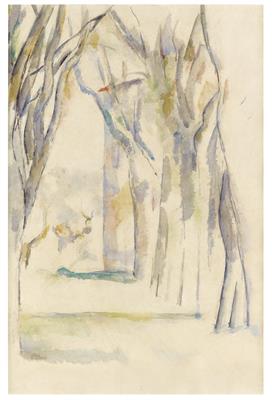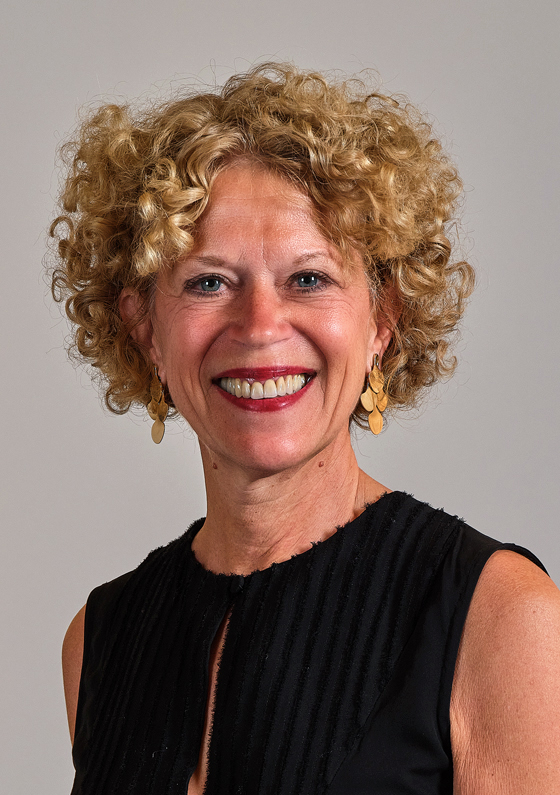Paul Cézanne

(Bouches du Rhone 1839–1906)
L’ Allée des Marronniers au Jas de Bouffan, c. 1890–1895, watercolour, gouache on Montgolfier laid paper, 48.8 x 32.7 cm, framed
The work is requested on loan for the following
Exhibition:
Luxembourg & Dayan Ltd London, Reconstructing Cézanne:
Sequence and process in Paul Cézannes works on paper,
01.10.–10.12.2019
Provenance:
Estate of Paul Cézanne, Galerie Bernheim-Jeune, Paris, 1907
Collection of Alphonse Kann (1870 – 1948), Saint-German-en-Laye,
27 January 1910
Collection of Max Silberberg (1878 – c. 1942), Wroclaw, until 1935
his forced sale, Paul Graupe, Berlin, 23 March 1935, lot 32
Collection of Carl Roesch (1884 – 1979), Diessenhofen, Switzerland
Thence by descent – Private Collection, Switzerland, until 2018
The work of art has been sold with the consent of the heirs of
Greta Silberberg following a settlement.
Literature:
Auction 141, Paul Graupe Berlin, 23.3.1935, Gemälde und Zeichnungen des 19. Jahrhunderts aus einer bekannten schlesischen Privatsammlung und aus verschiedenem Privatbesitz, cat. no. 32, ill.
Lionello Venturi, Cézanne, son Art, son Oeuvre, 2 Vol., Paris 1936 – reprint: Alan Wofsy fine arts, San Francisco 1989, cat. no. 956, pl. 291
Rewald, John, Paul Cézanne: The Watercolors, A Catalogue Raisonné, Boston/London, 1983, no. 321. ill.
“You have to treat nature in terms of the cylinder, the sphere, and the cone, with the whole scene put in perspective, that is to say that each side of an object, of a plane, moves towards a central point.”
Letter from Paul Cézanne to Émile Bernard, Aix-en-Provence, 15 April 1904
“Je reste le primitif de la voie que j’ai découverte”
(I remain the primitive of the path I have discovered)
Émile Bernard, Souvenirs sur Paul Cézanne et lettres inédites,
Mercure de France no. 247/ 248, Paris 1907, p. 385f/ p. 606f
Along with his contemporaries Vincent van Gogh and Paul Gauguin, Paul Cézanne numbers among the founding fathers of modern art. (Julius Maier-Gräfe, Entwicklungsgeschichte der modernen Kunst, Berlin 1904) Unlike the Impressionists, Cézanne focused on the compositional aspect of each piece and the autonomy of painting (“la peinture pour elle-même”) when creating his works. Cézanne’s understanding of nature (You have to treat nature in terms of the cylinder, the sphere, and the cone, with the whole scene put in perspective, that is to say that each side of an object, of a plane, moves towards a central point) underlines his approach to the harmony of his compositions, which is clearly visible in the work L‘Allée des Marronniers au Jas de Bouffan. Even brushstrokes lead the viewer’s eye down the chestnut-lined avenue, with the slight spatial distortion emphasising the essentially flat nature of the visual plane. The work L‘Allée des Marronniers au Jas de Bouffan illustrates the “sensation optique” created by the space that Paul Cezanne conjured up purely through the targeted use of lines and colours. He was convinced that drawing and colouring were of equal importance, erasing the traditionally clear division between lines and colours. “Both drawing and modelling are made reality in the act of applying paint, by the contrasts and relationships between the shades of colours.” (Fred Leeman, Malen “nach” Cézanne, in: exhibition catalogue Cézanne, Aufbruch in die Moderne, Ostfildern-Ruit 2004, p. 172f)
In the watercolour L‘Allée des Marronniers au Jas de Bouffan, the impression of structural harmony is primarily created by the linear tools used by Paul Cézanne. They provide this work with nuances created by a range of concentrations, from delicate grey to deepest black. The treetops in the left-hand portion of the foreground are relatively dark in tone, which, along with the broad horizontal planes inside the avenue, emphasise the avenue’s depth and heighten the illusion of space. In his letter to Émile Bernard dated 15 April 1904, Paul Cézanne writes of the central importance of these vanishing lines for the creation of space. “The lines running vertical to this horizon provide depth... Space is critically important if you want a painting to be exciting, as, for us humans, nature lives more in the depths than on the surface... Imitation, and even a certain amount of illusion, do not pose a danger if art is there.” (ibid.)
Tags:
Paul Cézanne, Paul Cezanne
Specialist: Dr. Petra Maria Schäpers
 Dr. Petra Maria Schäpers
Dr. Petra Maria Schäpers
petra.schaepers@dorotheum.de
04.06.2019 - 17:00
- Estimate:
-
EUR 280,000.- to EUR 350,000.-
Paul Cézanne
(Bouches du Rhone 1839–1906)
L’ Allée des Marronniers au Jas de Bouffan, c. 1890–1895, watercolour, gouache on Montgolfier laid paper, 48.8 x 32.7 cm, framed
The work is requested on loan for the following
Exhibition:
Luxembourg & Dayan Ltd London, Reconstructing Cézanne:
Sequence and process in Paul Cézannes works on paper,
01.10.–10.12.2019
Provenance:
Estate of Paul Cézanne, Galerie Bernheim-Jeune, Paris, 1907
Collection of Alphonse Kann (1870 – 1948), Saint-German-en-Laye,
27 January 1910
Collection of Max Silberberg (1878 – c. 1942), Wroclaw, until 1935
his forced sale, Paul Graupe, Berlin, 23 March 1935, lot 32
Collection of Carl Roesch (1884 – 1979), Diessenhofen, Switzerland
Thence by descent – Private Collection, Switzerland, until 2018
The work of art has been sold with the consent of the heirs of
Greta Silberberg following a settlement.
Literature:
Auction 141, Paul Graupe Berlin, 23.3.1935, Gemälde und Zeichnungen des 19. Jahrhunderts aus einer bekannten schlesischen Privatsammlung und aus verschiedenem Privatbesitz, cat. no. 32, ill.
Lionello Venturi, Cézanne, son Art, son Oeuvre, 2 Vol., Paris 1936 – reprint: Alan Wofsy fine arts, San Francisco 1989, cat. no. 956, pl. 291
Rewald, John, Paul Cézanne: The Watercolors, A Catalogue Raisonné, Boston/London, 1983, no. 321. ill.
“You have to treat nature in terms of the cylinder, the sphere, and the cone, with the whole scene put in perspective, that is to say that each side of an object, of a plane, moves towards a central point.”
Letter from Paul Cézanne to Émile Bernard, Aix-en-Provence, 15 April 1904
“Je reste le primitif de la voie que j’ai découverte”
(I remain the primitive of the path I have discovered)
Émile Bernard, Souvenirs sur Paul Cézanne et lettres inédites,
Mercure de France no. 247/ 248, Paris 1907, p. 385f/ p. 606f
Along with his contemporaries Vincent van Gogh and Paul Gauguin, Paul Cézanne numbers among the founding fathers of modern art. (Julius Maier-Gräfe, Entwicklungsgeschichte der modernen Kunst, Berlin 1904) Unlike the Impressionists, Cézanne focused on the compositional aspect of each piece and the autonomy of painting (“la peinture pour elle-même”) when creating his works. Cézanne’s understanding of nature (You have to treat nature in terms of the cylinder, the sphere, and the cone, with the whole scene put in perspective, that is to say that each side of an object, of a plane, moves towards a central point) underlines his approach to the harmony of his compositions, which is clearly visible in the work L‘Allée des Marronniers au Jas de Bouffan. Even brushstrokes lead the viewer’s eye down the chestnut-lined avenue, with the slight spatial distortion emphasising the essentially flat nature of the visual plane. The work L‘Allée des Marronniers au Jas de Bouffan illustrates the “sensation optique” created by the space that Paul Cezanne conjured up purely through the targeted use of lines and colours. He was convinced that drawing and colouring were of equal importance, erasing the traditionally clear division between lines and colours. “Both drawing and modelling are made reality in the act of applying paint, by the contrasts and relationships between the shades of colours.” (Fred Leeman, Malen “nach” Cézanne, in: exhibition catalogue Cézanne, Aufbruch in die Moderne, Ostfildern-Ruit 2004, p. 172f)
In the watercolour L‘Allée des Marronniers au Jas de Bouffan, the impression of structural harmony is primarily created by the linear tools used by Paul Cézanne. They provide this work with nuances created by a range of concentrations, from delicate grey to deepest black. The treetops in the left-hand portion of the foreground are relatively dark in tone, which, along with the broad horizontal planes inside the avenue, emphasise the avenue’s depth and heighten the illusion of space. In his letter to Émile Bernard dated 15 April 1904, Paul Cézanne writes of the central importance of these vanishing lines for the creation of space. “The lines running vertical to this horizon provide depth... Space is critically important if you want a painting to be exciting, as, for us humans, nature lives more in the depths than on the surface... Imitation, and even a certain amount of illusion, do not pose a danger if art is there.” (ibid.)
Tags:
Paul Cézanne, Paul Cezanne
Specialist: Dr. Petra Maria Schäpers
 Dr. Petra Maria Schäpers
Dr. Petra Maria Schäpers
petra.schaepers@dorotheum.de
|
Buyers hotline
Mon.-Fri.: 10.00am - 5.00pm
kundendienst@dorotheum.at +43 1 515 60 200 |
| Auction: | Modern Art |
| Auction type: | Saleroom auction |
| Date: | 04.06.2019 - 17:00 |
| Location: | Vienna | Palais Dorotheum |
| Exhibition: | 25.05. - 04.06.2019 |
